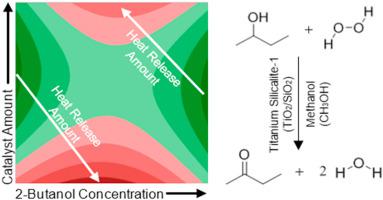Journal of Loss Prevention in the Process Industries ( IF 3.6 ) Pub Date : 2021-11-29 , DOI: 10.1016/j.jlp.2021.104703 Trent Parker 1 , Yiwei Mao 1 , Qingsheng Wang 1

|
In order to scale-up highly exothermic reactions for industrial use within the process industries, cooling requirements for these reactions must be determined so as to prevent thermal runaway and associated incidents. In this work, response surface methodology is utilized to identify operating regions for the synthesis of 2-butanone from 2-butanol that minimize the total heat released, based on the three parameters of initial 2-butanol concentration, titanium silicalite-1 amount, and operating temperature. For this, it was demonstrated that the 2-butanol concentration plays a more significant role in the total heat release compared with the reaction temperatures and catalyst amounts. Furthermore, a 2-butanol concentration of approximately 0.5 mol/L combined with either a low amount of titanium silicalite-1 of approximately 8 g (2.4 wt %) or high amount of approximately 15 g (4.8 wt %) resulted in higher total heat release amounts. This provides useful data regarding the combinations of parameters that will result in sufficiently low heat release amounts for the cooling capacity of industrial facilities when the reaction is scaled up for synthesis within the facilities.
中文翻译:

响应面法在使用 RC1 量热法进行 2-丁醇氧化为 2-丁酮的危害分析中的应用
为了在加工工业中扩大工业用途的高放热反应,必须确定这些反应的冷却要求,以防止热失控和相关事故。在这项工作中,基于初始 2-丁醇浓度、钛硅沸石-1 量和工作温度。为此,证明与反应温度和催化剂量相比,2-丁醇浓度在总热量释放中起着更重要的作用。此外,约 0.5 mol/L 的 2-丁醇浓度与约 8 g (2. 4 重量%)或约 15 克(4.8 重量%)的大量导致更高的总热量释放量。这提供了有关参数组合的有用数据,当反应按比例放大以在设施内合成时,这些参数组合将导致工业设施冷却能力的放热量足够低。







































 京公网安备 11010802027423号
京公网安备 11010802027423号